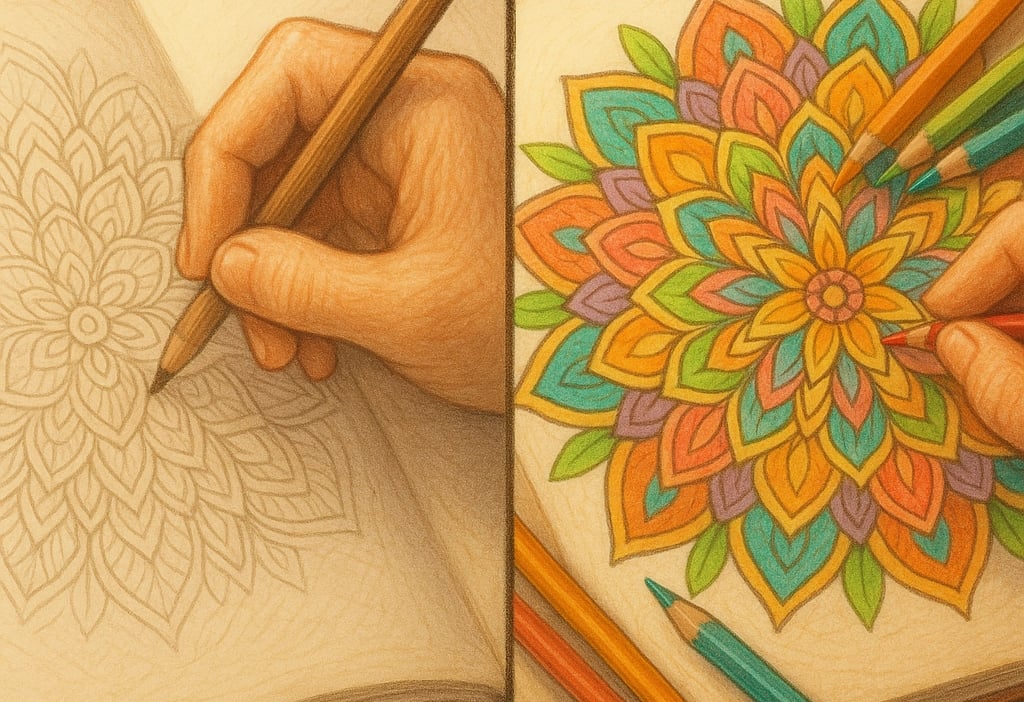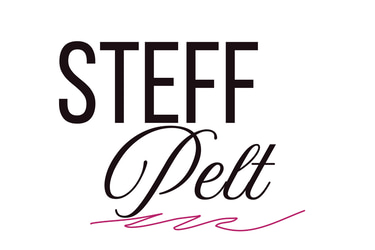Welcome to steff pelt!
Your bloHuman Creativity in the Age of AI: Why Hand-Drawn Art Still Matters in Publishingg post
Explore the importance of hand-drawn art in the age of AI and discover why human creativity is still essential in the publishing industry. Learn how traditional illustration brings unique value, authenticity, and emotional connection to books—even as digital tools and artificial intelligence reshape the world of publishing.
Penny Pelt
7/31/20255 min read


Human Creativity in the Age of AI: Why Hand-Drawn Art Still Matters in Publishing
In an era where artificial intelligence can generate artwork with a simple text prompt, a curious trend is emerging in the publishing world: hand-drawn art isn't disappearing—it's becoming more valuable. As digital tools reshape creative industries, the human touch in illustrations, coloring books, and puzzle designs offers something algorithms can't easily replicate: authenticity and emotional connection. This renaissance of hand-crafted art isn't just nostalgia; it represents a fundamental shift in how we value creativity in the digital age.
The Authenticity of Human Imperfection
When you open a coloring book or puzzle collection featuring hand-drawn art, you're not just seeing lines and shapes—you're witnessing the subtle tremors of a human hand, the pressure variations of a pencil, and the intentional (or unintentional) variations that make each piece unique. These "imperfections" are precisely what give hand-drawn art its character.
"The slight wobble in a line or the unexpected texture in shading creates visual interest that perfect, computer-generated symmetry often lacks," explains artist-publisher Emma Winters. "These details invite engagement because they feel approachable and real."
This authenticity is particularly important in activities like coloring, where the experience is meant to be relaxing and meditative. When people color inside hand-drawn lines, they're completing a creative collaboration with another human being—not just filling in computer-generated spaces.
Emotional Resonance Through Human Creation
The emotional connection to hand-drawn art runs deeper than aesthetics. Research suggests that knowing something was created by human hands fundamentally changes how we perceive it. This "human premium" explains why coloring books featuring artist-drawn illustrations continue to outsell their AI-generated counterparts, despite the latter's technical perfection.
As noted in why coloring is a powerful relaxation tool, the therapeutic benefits of coloring are enhanced when the designs have organic variation and flow. Hand-drawn mandalas, nature scenes, and abstract patterns carry the emotional imprint of their creators, offering a more meaningful experience than mathematically perfect alternatives.
"When I create coloring pages," says illustrator Marco Chen, "I'm thinking about the person who will color them. That human-to-human connection comes through in the final product. An algorithm doesn't care if someone enjoys coloring its output."
The Hybrid Revolution: Combining Traditional and Digital Techniques
Perhaps the most exciting development isn't the competition between AI and human artists but their collaboration. Many contemporary illustrators now employ hybrid approaches—sketching concepts by hand, refining them digitally, then adding final hand-drawn elements to maintain that crucial human touch.
This blend of techniques has revolutionized publishing, particularly in educational materials and activity books. Take puzzle design, for instance. The foundation might be sketched by hand, digitally refined for clarity, then enhanced with hand-drawn details that make solving the puzzle a uniquely human experience.
For coloring book creators, this hybrid approach allows for innovations like:
Hand-drawn outlines with digitally enhanced textures
Traditional watercolor backgrounds with precisely calibrated line work
Hand-lettered text integrated into digital layouts
Custom illustrations that incorporate both spontaneous and calculated elements
These combinations offer the best of both worlds: the warmth and uniqueness of human creativity with the precision and reproducibility of digital tools.
Educational Value: Learning Through Human-Created Materials
The educational impact of hand-drawn art extends beyond aesthetics. When children interact with hand-drawn materials—whether coloring books, educational puzzles, or illustrated stories—they're exposed to the natural variations of human expression. This subtle but important difference helps develop visual literacy and creative thinking.
"Children naturally imitate what they see," explains educational psychologist Dr. Vanessa Liu. "When they color in hand-drawn designs, they're subconsciously absorbing organic forms and variations. This influences their own drawing style and helps them understand that creativity isn't about perfection."
This perspective is reflected in the growing popularity of ergonomic art supplies for children, as detailed in our guide to ergonomic crayons. These tools are designed to complement the natural, imperfect nature of hand-drawing, encouraging children to embrace the human aspects of creativity rather than striving for digital precision.
Market Differentiation in Publishing
From a business perspective, human-created art offers publishers a powerful differentiator in an increasingly automated market. With AI-generated art becoming more common and accessible, the human element becomes a premium feature.
Sarah Beetson of IllustrationX notes that art directors and publishers specifically seek work showing evidence of the artist's hand—whether that's visible pencil marks, brush strokes, or other tactile elements. This preference isn't merely aesthetic; it's strategic market positioning.
The trend is particularly evident in specialized publishing niches like:
Adult coloring books highlighting artist collaborations
Limited-edition puzzle collections featuring renowned illustrators
Children's books that emphasize the illustrator's unique style
Interactive activity books that showcase artistic techniques
As AI-generated imagery becomes more prevalent, publishers can distinguish their offerings by emphasizing the human creativity behind their products. Some have begun including "artist profiles" or "behind the scenes" features showing the creation process—something impossible with purely AI work.
The Value of Space and Time in Creative Process
One of the most significant differences between human and AI art lies in the creation process itself. Human artists require physical space, materials, and—most importantly—time to develop their work. This investment creates value that transcends the final product.
"When I set up my perfect space for coloring books," says creative consultant Ellie Patel, "I'm creating an environment for slow, mindful creativity. This approach influences not just how I color, but how I create original art as well."
The deliberate pace of hand-drawing allows for reflection, revision, and discovery—qualities that often produce more nuanced results than rapid AI generation. For publishers of coloring books and creative activities, emphasizing this thoughtful creation process adds perceived value to their products.
The Future Balance: Complementary Strengths
Rather than an either/or proposition, the future of publishing likely involves leveraging the complementary strengths of both human creativity and AI capabilities. AI might handle repetitive elements or technical challenges, while human artists focus on unique creative expressions that algorithms can't easily replicate.
In practical terms, this might look like:
AI generating background patterns for human-designed coloring book foregrounds
Algorithms optimizing puzzle difficulty while humans create visually engaging themes
Digital tools handling production logistics while artists focus on creative decisions
AI suggesting color palettes that human designers refine for emotional impact
This collaborative approach allows publishers to maintain efficiency without sacrificing the human elements that consumers value. The key is transparency—being clear about where human creativity ends and technological assistance begins.
Embracing Human Creativity in a Digital World
As we navigate this evolving landscape, both creators and consumers have opportunities to intentionally value human artistic expression. For those who enjoy coloring, puzzles, and creative activities, this might mean:
Looking for publications that credit their human artists
Participating in 30-day coloring challenges that celebrate hand-drawn designs
Learning about the artists behind favorite creative activities
Sharing and displaying completed coloring projects to continue the human creative chain
Publishers can embrace this trend by highlighting their human creators, showcasing behind-the-scenes creative processes, and being transparent about their use of technology as a tool rather than a replacement for human imagination.
Conclusion: The Enduring Value of Human Touch
In the publishing world, particularly for creative activities like coloring books and puzzles, the human element remains irreplaceable. While AI offers incredible capabilities, it's the distinctive mark of human creativity—with all its beautiful imperfections and emotional resonance—that continues to captivate and inspire.
As technology advances, the value of hand-drawn art isn't diminishing—it's being highlighted through contrast. In a world where perfect digital reproduction is commonplace, the unique variations of human creation stand out more distinctly than ever before.
For publishers, creators, and enthusiasts alike, this represents not a conflict but an opportunity: to appreciate technology's capabilities while celebrating and preserving the irreplaceable value of human artistic expression. In this balanced approach lies the future of creative publishing—one where both AI and human creativity have important, complementary roles to play.
Check out my Free Hub for more creative resources: https://www.steffpelt.com/your-free-hub
info@steffpelt.com
Some links on this site are affiliate links. This means that if you make a purchase through these links, I may earn a commission at no extra cost to you. These affiliations help me continue to create valuable content and share relevant recommendations. The majority of the commissions I receive come from Amazon. Thank you for your support!
